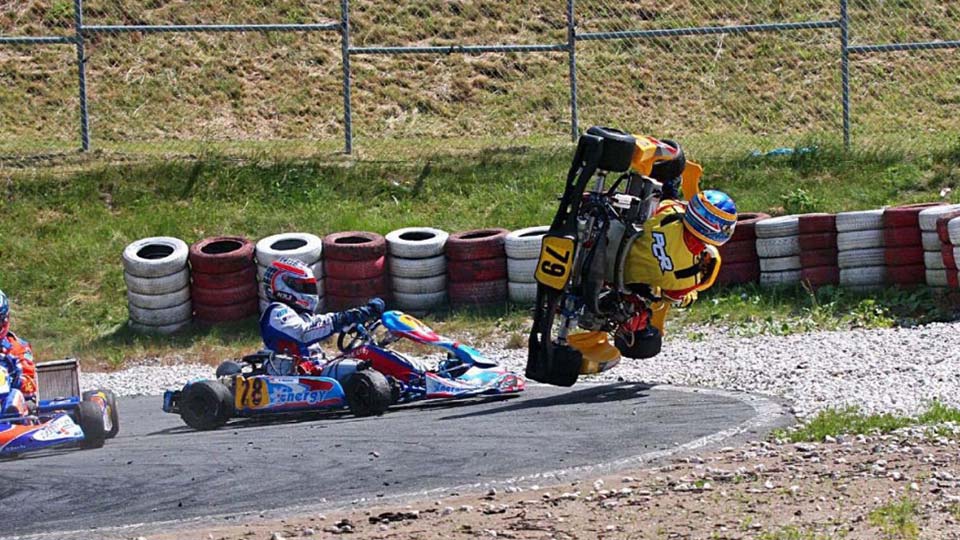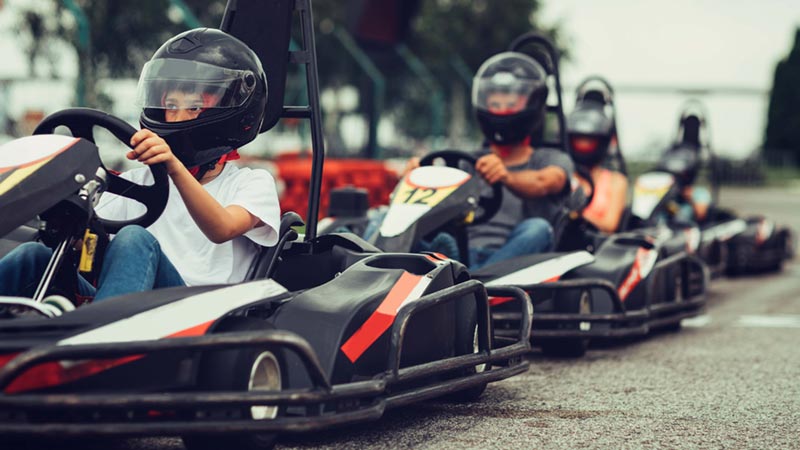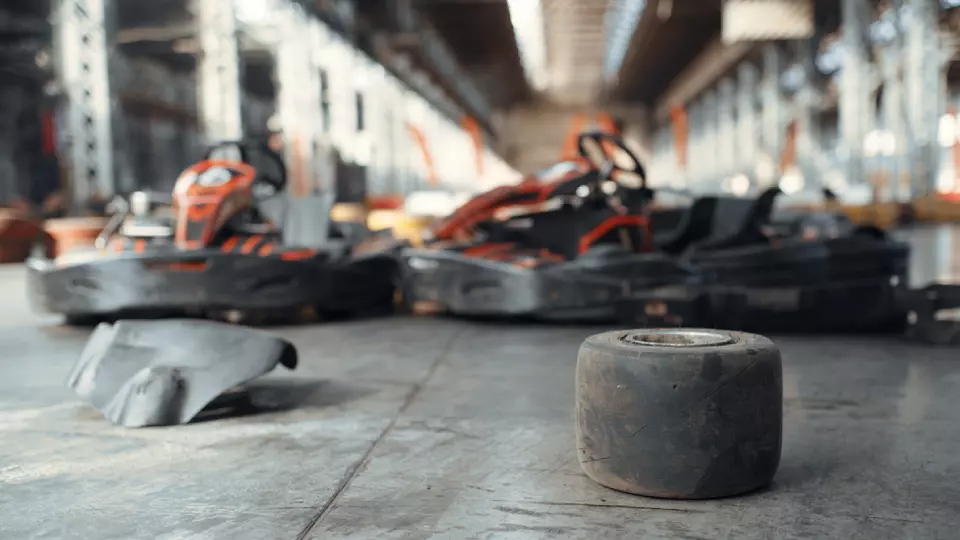Go-karting is a motorsport with a low barrier to entry, that is suitable for people of all ages. While it may be a hobby or a leisure activity for some, many go-kart racing professionals take this motorsport seriously and participate in various leagues and championships.
While go-kart racing is fun, it can come with certain risks, particularly due to human errors, accidents, collisions, and more. What can make kart racing particularly dangerous is the open design of the go-kart itself.
They’re open-wheeled vehicles and don’t have an enclosed chassis, meaning that the driver is constantly exposed to the environment. While rare, typical injuries when racing go-karts are whiplashes, fractures, and sprains.
However, this doesn’t mean that it’s not safe. Go-kart racing is safe, when drivers use protective gear, maintain their go-karts regularly and understand the rules and regulations of racing.
Here is a quick summary of the content:
- Go-Kart Safety Statistics
- How Go-Kart Accidents and Injuries Occur
- Common Go-Kart-Related Injuries
- Safety Tips & Preventive Measures
In this article, we’ll be taking a closer look at go-kart racing safety, in terms of statistics, common injuries, safety tips, and preventive measures. Remember that go-kart racing can be safe if you follow best racing practices and all of the recommended safety measures that are covered in this article!
Go-Kart Safety Statistics
The U.S. Consumer Product Safety Commission (CPSC) researched the safety of go-karts in 2000. The CPSC concluded that more than 10,000 people visited an emergency room due to an incident that occurred while racing go-karts. Around 67% of those people are children below the age of 15.
After many safety upgrades and technological advancements during the past 20 years, and a consistent focus on safety from go-kart racing facilities and sanctioned races, the annual number of go-kart incidents per person has decreased (the total number has increased due to the rise in popularity of go-kart racing, but the cases per person have reduced).
| Injury Type | Number | Percentage |
|---|---|---|
| Head & Neck Injuries | 70 | 12% |
| Trunk & Spinal Injuries | 230 | 39% |
| Shoulder, Hand & Arm Injuries | 130 | 22% |
| Hip, Leg & Foot Injuries | 150 | 26% |
| Other Injuries | 20 | 3% |
| Total Injuries | 600 | 100% |
Source: Letsel Informatie Systeem 2001-2005, Consumer Safety Institute
Data also showed that most of the injuries occurred in children that were aged between 8 – 14. This is mainly because their reactions are slower than adults, and their situational awareness and assessment are not quick enough to mitigate potential accidents, which typically occur at higher speeds.
While most safety incidents are minor, there are occasionally cases that have caused serious injury. For example, the FIA Karting European Championship witnessed a major accident where multiple go-karts crashed into the barriers after failing to round a corner.
Furthermore, a study called Mechanisms and Injuries Associated with Go-Karting highlighted that safety measures are necessary to further improve go-karting safety statistics, and a lack of following these measures will see an increase in accidents and injury to racers.
These situations happen from time to time and are not necessarily rare occurrences. However, increased safety standards and improved racing skills and training sessions have been effective countermeasures over the years.
How Do Go-Kart Racing Accidents and Injuries Occur?
Injuries typically occur when racers and race marshals fail to maintain safe racing practices, when the racing conditions are challenging, or when go-karts are not well maintained. Here’s a list of factors and scenarios that may lead to accidents and injuries:
- Driver (inexperienced, distracted, etc.)
- Race Track (oil spills, challenging design, lack of safety features, etc.)
- Weather Conditions (rain, snow, haze, etc.)
- Go-Kart (part or component failure, lack of maintenance, etc.)
Common Karting Injuries
While most injuries that arise from go-kart racing are not severe, some may be potentially life-threatening. It goes without saying that racers must always ensure to wear the recommended safety equipment and practice safe racing.

In this section, we’ll be taking a closer look at go-kart racing-related injuries that commonly occur. Please take note that the statistics that are mentioned below are derived from a well-researched study on injuries associated with go-karting.
Below is a list of common kart-related injuries:
- Burns
- Whiplash
- Fractures
- Bruising
- Sprains
- Head trauma
- Abdominal trauma
- Chest trauma
Fractures
Go-kart incidents can cause direct trauma to your fingers, foot, ankles, ribs, pelvis, lower limbs, and hip. The annual number of emergency room visits showed 26% cases of lower-body fractures, 22% of arms, hands, and shoulders, and 6% of rib fractures.
The pedals may even cause lower limb and foot fractures when an accident happens. Hands and limbs may get fractured after losing control of the steering wheel, and the middle section can sustain fractures following a full-body collision.
Contusions
Bruising is a typical injury that occurs during karting accidents. Take note that most contusions heal over time and are deemed non-serious, unless the contusions are internal, such as lung contusions (highly possible in a serious karting accident!)
Out of the people who were admitted to the hospital for go-kart-related injuries, about 7% of racers suffered hip contusions, 5% suffered from head bruises, and 5% with shoulder and arm contusions.
Abrasions
Abrasions are typically caused when racers make direct contact with the track. If a driver suffers an accident on the kart track, the go-kart may flip over flinging the driver out who can slide across the race track.
Lacerations
Lacerations are typically a result of accidents where the driver makes contact with a sharp object that causes injury to the arms, shoulders, trunk, lower limbs, hip, feet, and sometimes even the head (if no helmet is worn).
Among these injuries, the ones suffered by the body’s trunk are most common. About 28% of people who were admitted to an emergency due to go-kart-related injuries suffered from lacerations.
Whiplashes
Whiplashes are sudden movements that are caused when a racer’s go-kart collides with another go-kart or a safety barrier. This sudden movement causes the neck to bend forcefully, subsequently causing injury. Whiplash recoveries may take anywhere between 2 to 3 months to heal.
Burn Wounds
Burn wounds can be caused by overheating engines, fuel or oil leakages, engine malfunctions, or simply damage to the engine. While rare, burn wounds typically arise when a go-kart catches fire and the racer suffers from burns.
Safety Tips & Preventive Measures
While the list of injuries may be unappealing and discouraging to some, take note that most accidents happen when racers are unqualified, practices unsafe driving, and don’t wear the required safety equipment. This doesn’t mean that go-karting is unsafe, it is safe!

Go-karting can be a safe motorsport if all of the following recommended safety measures are implemented and practiced at all times. Please take note that not everything may always be in your direct control, such as track and weather conditions or the driving behavior of other racers.
However, it’s in your best interest to get yourself acquainted with the best practices of go-kart racing, which I will share with you in the following section. Most karting-related accidents and resulting injuries occur when humans make mistakes and ignore the warning signs of mechanical, technical, and environmental aspects.
Therefore, it’s extremely important that you place safety as the utmost important aspect of go-kart racing – and this at all times! While the external factors cannot be controlled, such as weather or the intentions of other racers, you can prevent major injuries by following a set of safety tips that I will outline below.
1. Wear Proper Go-Kart Safety Equipment
Go-kart safety equipment prevents injuries, such as burn wounds, head trauma, lacerations, trunk trauma, fractures, and even whiplashes. Racing with proper karting gear is necessary to ensure a safe and fun go-kart racing experience.
Make sure to check out my complete guide on go-kart racing safety gear. Please keep in mind the benefits of safety equipment below:
- Helmet: Can prevent head injuries
- Gloves: Can prevent hand and finger injuries and improves wheel grip
- Karting Suit: Can protect your body from abrasions and lacerations
- Karting Shoes: Can prevent foot injuries
- Neck Brace: Can avoid whiplashes and hyperextension
- Rib Protector: Can prevent trauma to the chest and upper body
2. Read Go-Kart Related Guides & Articles
A great way to avoid any type of potential accident is to stay informed about relevant go-kart-related articles and guides. You should fully understand how go-karts work, how to fix specific problems, and how to do effective go-kart maintenance.
The more information you have and the more you know about how your go-kart functions on and off the track, the better your decision-making skills will be during a race. Situational awareness, quick thinking, and knowledge can prevent accidents and injuries.
My website has all the resources you need to learn about go-kart racing. Through years of racing go-karts and countless hours of research, I have written extensively about go-karts. My content is completely free, so make sure to check out my articles and guides. I hope that it will help you out!
3. Practice Safe Driving
Go-karting can be a highly competitive motorsport. However, accidents can be prevented when practicing safe driving. Children and teenagers, in particular, need to learn various go-karting techniques to keep them safe during a race.
It’s important to learn karting techniques like overtaking, accelerating, and cornering carefully and effectively before participating in an actual race. Better racers cause fewer accidents and are also prone to less injury.
4. Get Proper Training
Learn how to race go-karts before actually racing go-karts! Understand how they work and what to pay attention to. There are multiple online courses and real-world training resources available.
If required, you should also get help from instructors or your local community and practice on the track. This will give you an idea of what to expect during the race and how you can control your go-kart in all types of situations.
Feel free to start with my guide on how to race go-karts for the first time. Here, I highlight the most essential tips and tricks for beginners.
5. Familiarize Yourself with Go-Kart Safety Flags
Another important aspect of kart racing is your understanding of go-kart safety flags. These flags are waived by track marshalls when an incident has occurred and are designed to keep you updated on the racing situation.
Unfortunately, many racers fail to keep an eye out for the flags, know what they mean, and more importantly understand what to do when they see them. There are a total of seven flags and the race marshals raise them to signal important things such as caution, stop passing, infractions, and more.
They can even be used to stop a race, in the event of an accident. Therefore, pay close attention to the track marshals at all times!
6. Progress Incrementally
Going from a few practice sessions to a pro-level racing event is an amateur mistake that can easily result in injuries. More professional racing classes and categories come with increased risks, due to higher speeds, more skillful and aggressive racers, as well as more challenging race tracks.
Therefore, progress carefully and pass each class when you feel that you’re ready – there is no need to rush! Stay calm, collected, and excited while you learn to race go-karts, as you’re meant to not only stay competitive but also to have fun!
7. Familiarize Yourself with FIA-CIK Safety Standards
FIA-CIK stands for Commission Internationale de Karting, which is the sole international body that establishes regulations for karting. Their responsibility is to set the standards for track and championship regulations and also for the technical aspects of go-karts.
It would help if you familiarize yourself with the sporting and technical regulations if you plan to race in any FIA-CIK sanctioned races (it’s also good practice to get an understanding of these regulations for casual racers).
8. Do Proper Go-Kart Maintenance
Racers who want to use their own go-karts on the race track or anywhere else must maintain them properly. If you have been a go-karting fan for a while, you will know that some accidents on the track occur as a result of part or component failure.
From the engine and wheels to the safety belt and roll bar, maintain all parts of your go-kart so that they don’t cause accidents. For proper maintenance schedules and requirements, check the owner’s guide of the manufacturer.
Conclusion
To summarize, go-kart racing can be safe and fun, if you follow the racing guidelines, understand how go-karts work, practice safe driving and wear the appropriate safety gear. However, never underestimate external factors such as track, driver, and weather conditions, as they can increase the risk of accidents and injuries.
And lastly, race safely and have fun on the track!

